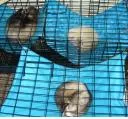
Ferret Bedding
 If you’re planning on introducing a ferret into your home as a pet, congratulations! These little guys are intelligent, endlessly entertaining, and easy to train once you know how they process information. The domestic ferret is a member of the weasel family and are very popular and lovable house pets. Like any pet, setting up your ferret’s cage environment is very important to its health and happiness. Ferret bedding is one of those issues that you’ll need to educate yourself about before you bring your pet home. Ferrets sleep fifteen to eighteen hours (not in a row!) a day in their cage, making their bedding all the more essential. Just as you would choose a bed that is comfortable, clean, and provides protection from cold, the type of ferret bedding you chose is just as important to your pet.
If you’re planning on introducing a ferret into your home as a pet, congratulations! These little guys are intelligent, endlessly entertaining, and easy to train once you know how they process information. The domestic ferret is a member of the weasel family and are very popular and lovable house pets. Like any pet, setting up your ferret’s cage environment is very important to its health and happiness. Ferret bedding is one of those issues that you’ll need to educate yourself about before you bring your pet home. Ferrets sleep fifteen to eighteen hours (not in a row!) a day in their cage, making their bedding all the more essential. Just as you would choose a bed that is comfortable, clean, and provides protection from cold, the type of ferret bedding you chose is just as important to your pet.
Let’s take a look at the necessities of housing your pet, including essential life-saving information about ferret bedding. First, your ferret should have a roomy ferret-specific cage made of sturdy wire; don’t house your ferret in a glass aquarium-type cage. Your pet needs lots of air circulation to prevent moisture collection on the bottom of the cage; this could cause both odor and health problems for your ferret. It’s extremely important that you never line the bottom of your pet’s cage with cedar or pine chips or use them as ferret bedding. These chips contain dust and oils that may be very harmful to your ferret’s respiratory system and liver when used as ferret bedding or cage bottom lining. Instead, use a ferret-specific cage and cover the bottom of the cage and any wire mesh with a washable throw rug or soft (and hardy) pieces of cloth. Put a corner litter pan on one side of the cage and food and water on the opposite side of the cage. This will encourage them to use the litter pans. Ferrets will generally not use the bathroom around their food area.
Your ferret’s bedding should provide a soft place to sleep and hide. Before they were domesticated, ferrets chose bedding that provided darkness, comfort and protection from predators and the weather. Cover the outside of the top (or sleeping level) of the cage with a sheet or blanket to make it dark and private. Good choices for ferret bedding are ferret-specific hammocks or sleep sacks that hang from the cage. Try putting some ferret bedding and durable fabric on the different levels of the cage. Ferrets love to crawl inside soft materials. Choose tougher fabrics because some ferrets may chew on fabric and can get intestinal blockages if they swallow pieces of material. Watch your ferret’s bedding to be sure it’s not being chewed or is missing pieces; if they are, remove the material promptly. Ferrets should not be walking on wire grating or wire mesh alone since this is not only uncomfortable, but can injure their feet as well. Cover the bottom of the cage and any wire mesh levels with felt or other material that a ferret won’t catch his or her claws in.
Your safest and best litter is recycled paper in pellets, not clumping litter, or clay litter unless it is dust free. Look for pellet litter designed for ferrets containing recycled paper. We have a nice selection in the ferret store, and a great option for a new ferret owner is a custom bedding set- You can
Buy Ferret Bedding
online here.